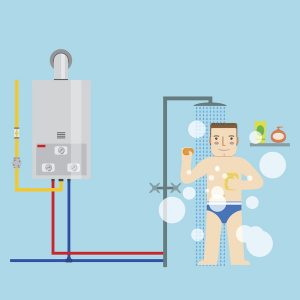A toilet that runs is a fairly common problem for Birmingham area homeowners – at some point, it’ll probably happen to you if it hasn’t already. Luckily, a toilet that doesn’t seem to turn off is often easily solved, even without the help of a plumber. Save yourself a service call – Douglas Cooling & Heating explains how to fix a running toilet tank before you enlist the help of one of our licensed Alabama plumbers.
Flapper Issues Causing a Running Toilet Tank
When you flush your toilet, the handle is connected to an arm inside the tank, which has a chain that hangs down and connects to the flapper. Pulling the handle causes the arm to raise, in turn raising the flapper. When the flapper opens, water flushes into the bowl from the tank. When the lever goes back down, the flapper should also shut, closing off the tank and allowing it to refill.
If the flapper fails to seal at the bottom of the tank, your toilet may run. Here’s how to fix a running toilet tank caused by a faulty flapper:
- Take the lid off your toilet tank and set it aside.
- Find the flapper’s position at the bottom of the toilet tank.
- See if the flapper is stuck open – there may be a kink in the chain. If so, straighten out the chain and see if this stops the toilet from running.
- If the flapper appears closed, it may not have formed a good seal at the bottom of the tank. Check for debris that could be in the way or heavy mineral buildup causing an imperfect seal. Remove or clean away debris to see if the flapper will seal.
- If the flapper itself is damaged or cracked, the toilet will run, and you’ll need to replace the flapper entirely. This can be a DIY plumbing repair for some homeowners while others prefer to leave it to the pros. Whichever you prefer, feel free to call Douglas Cooling & Heating should you experience difficulty doing so.
Valve Leaks Behind a Running Toilet
After the flapper seals the tank closed, the toilet’s fill valve will add water to the tank until it is refilled. If the toilet fill valve leaks, the toilet can continue to run. Fixing a running toilet tank with a leaky fill valve involves the following steps:
- Remove the tank lid and set it aside.
- Flush the toilet using the outside lever.
- After the toilet flapper closes, watch the tank fill. When water in the tank is about one inch lower than the overflow pipe (the pipe that’s open at the top), raise the float upward to stop the fill valve.
- If the fill valve still runs even after you raise the float up, there is a leak in the valve. The valve will need replacement. Installing a new fill valve isn’t as easy as replacing a flapper – call Douglas Cooling & Heating and let one of our plumbers handle this repair.
Bad Lever Causing a Running Toilet
If it’s not a bad flapper or fill valve causing the toilet to run, the flush lever may be to blame. When you flush the toilet, the lever should never stick downwards. If it does, it will cause the flush arm to hold the flapper open and continuously dump water into the bowl.
Fixing a bad flush lever involves these steps:
- Remove the tank lid.
- Check the flush arm for corrosion or damage.
- If the flush arm is damaged, replace it. You can DIY this repair if you’re comfortable or call Douglas Cooling & Heating and let your plumber do the job.
Need Help Fixing Toilet Troubles?
If you’re having trouble fixing a running toilet, don’t hesitate to call Douglas Cooling & Heating for professional help. Our plumbers are happy to help you solve toilet troubles like this! Contact us today to make an appointment for repair services.

 Whether you water heater is on its last leg or you are simply trying to look for ways to save, you may want to consider a tankless water heater. Tankless water heaters are exactly what they sound like, water heating systems that don’t require a multi-gallon tank to hold hot water. This may sound strange if you don’t know how these systems work but we are happy to fill you in. What’s more, our team is glad to help you switch over to a tankless system if it is the best fit for your home.
Whether you water heater is on its last leg or you are simply trying to look for ways to save, you may want to consider a tankless water heater. Tankless water heaters are exactly what they sound like, water heating systems that don’t require a multi-gallon tank to hold hot water. This may sound strange if you don’t know how these systems work but we are happy to fill you in. What’s more, our team is glad to help you switch over to a tankless system if it is the best fit for your home.
